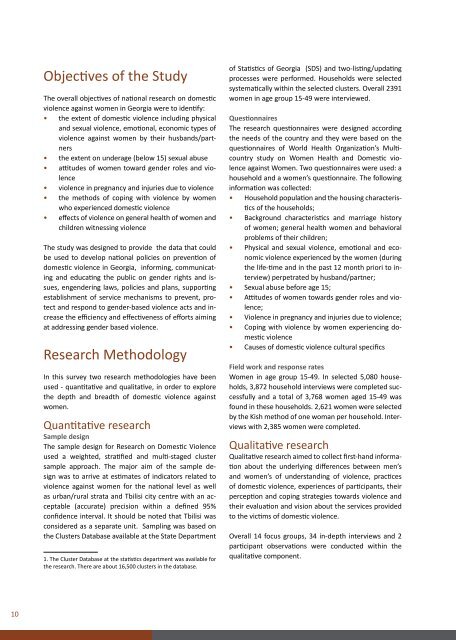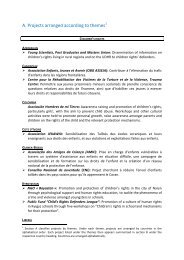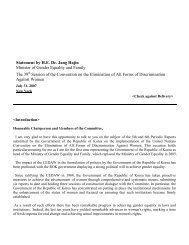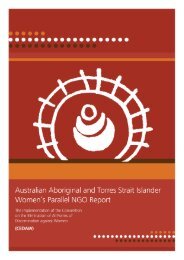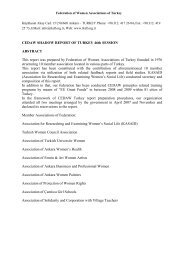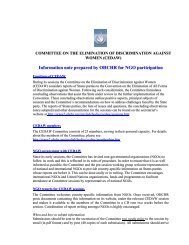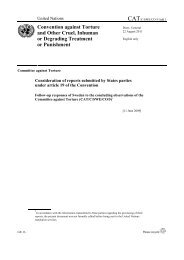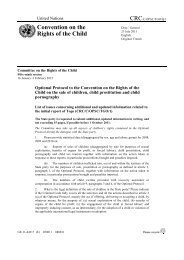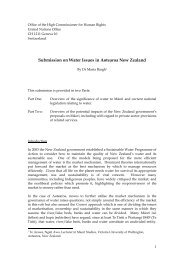National Research on Domestic Violence Against Women in
National Research on Domestic Violence Against Women in
National Research on Domestic Violence Against Women in
You also want an ePaper? Increase the reach of your titles
YUMPU automatically turns print PDFs into web optimized ePapers that Google loves.
Objectives of the StudyThe overall objectives of nati<strong>on</strong>al research <strong>on</strong> domesticviolence aga<strong>in</strong>st women <strong>in</strong> Georgia were to identify:• the extent of domestic violence <strong>in</strong>clud<strong>in</strong>g physicaland sexual violence, emoti<strong>on</strong>al, ec<strong>on</strong>omic types ofviolence aga<strong>in</strong>st women by their husbands/partners• the extent <strong>on</strong> underage (below 15) sexual abuse• attitudes of women toward gender roles and violence• violence <strong>in</strong> pregnancy and <strong>in</strong>juries due to violence• the methods of cop<strong>in</strong>g with violence by womenwho experienced domestic violence• effects of violence <strong>on</strong> general health of women andchildren witness<strong>in</strong>g violenceThe study was designed to provide the data that couldbe used to develop nati<strong>on</strong>al policies <strong>on</strong> preventi<strong>on</strong> ofdomestic violence <strong>in</strong> Georgia, <strong>in</strong>form<strong>in</strong>g, communicat<strong>in</strong>gand educat<strong>in</strong>g the public <strong>on</strong> gender rights and issues,engender<strong>in</strong>g laws, policies and plans, support<strong>in</strong>gestablishment of service mechanisms to prevent, protectand resp<strong>on</strong>d to gender-based violence acts and <strong>in</strong>creasethe efficiency and effectiveness of efforts aim<strong>in</strong>gat address<strong>in</strong>g gender based violence.<str<strong>on</strong>g>Research</str<strong>on</strong>g> MethodologyIn this survey two research methodologies have beenused - quantitative and qualitative, <strong>in</strong> order to explorethe depth and breadth of domestic violence aga<strong>in</strong>stwomen.Quantitative researchSample designThe sample design for <str<strong>on</strong>g>Research</str<strong>on</strong>g> <strong>on</strong> <strong>Domestic</strong> <strong>Violence</strong>used a weighted, stratified and multi-staged clustersample approach. The major aim of the sample designwas to arrive at estimates of <strong>in</strong>dicators related toviolence aga<strong>in</strong>st women for the nati<strong>on</strong>al level as wellas urban/rural strata and Tbilisi city centre with an acceptable(accurate) precisi<strong>on</strong> with<strong>in</strong> a def<strong>in</strong>ed 95%c<strong>on</strong>fidence <strong>in</strong>terval. It should be noted that Tbilisi wasc<strong>on</strong>sidered as a separate unit. Sampl<strong>in</strong>g was based <strong>on</strong>the Clusters Database available at the State Department1. The Cluster Database at the statistics department was available forthe research. There are about 16,500 clusters <strong>in</strong> the database.of Statistics of Georgia (SDS) and two-list<strong>in</strong>g/updat<strong>in</strong>gprocesses were performed. Households were selectedsystematically with<strong>in</strong> the selected clusters. Overall 2391women <strong>in</strong> age group 15-49 were <strong>in</strong>terviewed.Questi<strong>on</strong>nairesThe research questi<strong>on</strong>naires were designed accord<strong>in</strong>gthe needs of the country and they were based <strong>on</strong> thequesti<strong>on</strong>naires of World Health Organizati<strong>on</strong>’s Multicountrystudy <strong>on</strong> <strong>Women</strong> Health and <strong>Domestic</strong> violenceaga<strong>in</strong>st <strong>Women</strong>. Two questi<strong>on</strong>naires were used: ahousehold and a women’s questi<strong>on</strong>naire. The follow<strong>in</strong>g<strong>in</strong>formati<strong>on</strong> was collected:• Household populati<strong>on</strong> and the hous<strong>in</strong>g characteristicsof the households;• Background characteristics and marriage historyof women; general health women and behavioralproblems of their children;• Physical and sexual violence, emoti<strong>on</strong>al and ec<strong>on</strong>omicviolence experienced by the women (dur<strong>in</strong>gthe life-time and <strong>in</strong> the past 12 m<strong>on</strong>th priori to <strong>in</strong>terview)perpetrated by husband/partner;• Sexual abuse before age 15;• Attitudes of women towards gender roles and violence;• <strong>Violence</strong> <strong>in</strong> pregnancy and <strong>in</strong>juries due to violence;• Cop<strong>in</strong>g with violence by women experienc<strong>in</strong>g domesticviolence• Causes of domestic violence cultural specificsField work and resp<strong>on</strong>se rates<strong>Women</strong> <strong>in</strong> age group 15-49. In selected 5,080 households,3,872 household <strong>in</strong>terviews were completed successfullyand a total of 3,768 women aged 15-49 wasfound <strong>in</strong> these households. 2,621 women were selectedby the Kish method of <strong>on</strong>e woman per household. Interviewswith 2,385 women were completed.Qualitative researchQualitative research aimed to collect first-hand <strong>in</strong>formati<strong>on</strong>about the underly<strong>in</strong>g differences between men’sand women’s of understand<strong>in</strong>g of violence, practicesof domestic violence, experiences of participants, theirpercepti<strong>on</strong> and cop<strong>in</strong>g strategies towards violence andtheir evaluati<strong>on</strong> and visi<strong>on</strong> about the services providedto the victims of domestic violence.Overall 14 focus groups, 34 <strong>in</strong>-depth <strong>in</strong>terviews and 2participant observati<strong>on</strong>s were c<strong>on</strong>ducted with<strong>in</strong> thequalitative comp<strong>on</strong>ent.10


